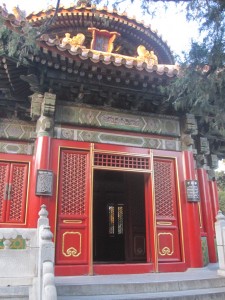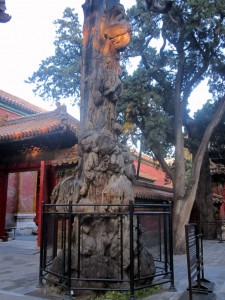The Forbidden City, aka as the Palace Museum or Imperial Palace is an enormous city built during the early part of the 15th century for the Chinese Emperor and his retinue, thus it’s name Forbidden as it excluded all but a select few. It has been rebuilt and restored during its lifetime. More information can be found at sites such as http://museumca.org/exhibit/exhib_fc2.html
or http://factsanddetails.com/china.php?itemid=429&catid=15&subcatid=94
It has now been open to the public for 85 years and a display of treasures in a room atop the Wumen/Meridian Gate had free entry to celebrate this fact.
Tiananamen Gate on Saturday.
Tiananmen Gate three weeks earlier. The flowers were present to celebrate China’s National Day on October 1.
Most people enter the Forbidden City from Tiananmen Square in the south. However, three gates and accompanying courtyards must be traversed before arriving within the Forbidden City. The first gate encountered from the south is Tiananmen, followed by Duan and then Wumen or Meridian Gate, the largest gate to the city. There are buildings and gardens in large walled spaces on either side of these gates and courtyards which apart from a brief visit as part of a scam, I was taken to a painting exhibition with the hope that I would purchase and I didn’t because I was well and truly lied to, I haven’t yet visited. Such scams are extremely common in such historical areas.
One of the entrances in Tiananmen Gate. Portraits of Mao are ready for replacement whenever necessary.
Tiananmen Square from Tiananmen Gate showing Monument to the Peoples Heroes and Mao Zedong’s Mausoleum.
Tourists on the review area used by senior leaders. Entry required an additional fee. Entry fees to many tourist sites and accommodation in Beijing dropped from November 1st in recognition of cold weather.
View from Tiananmen Gate showing part of the square and a museum closed for renovation.
Guards being reviewed near the Duan Gate.
Guards boots lined up outside accommodation near the Meridian Gate. There was a row of black shoes too. They had a basketball court and a small building used as a laundry.
View from the Meridian Gate, which is u shaped, back towards the Duan Gate.
National Center of the Performing Arts just visible from the Meridian Gate. It is constructed from glass and titanium with a man made watercourse around it. It was controversial and requires government subsidy.
The pagoda and temple at Behai Park visible from Meridian Gate.
Back of the Meridian Gate
After exiting Meridian Gate the vista is of a huge enclosed courtyard having a channeled stream with five bridges atop it. Behind it is a wooden gate flanked by bronze lions leading to a large rectangular building atop three layers of marble. This building was used for important state occasions. Behind it is a small square building and another rectangular building. These buildings had various functions but were for formal state occasions. Behind the last building is a large marble stone carved with dragons and clouds. It is 600 years old and famous for its size. There are many smaller such ramps alongside steps in the city. The emperor was carried over them in his sedan chair. Gates lead to other parts of the city much of which is not open to the public. However, there is enough to keep an interested visitor engaged for days. The level of restoration and style of restoration varies. Some of it hasn’t lasted long with a 2005 restoration already losing gold paint or gilding.
View from Meridian Gate of hugh courtyard showing stream, bridges and wooden gate in the centre.
Hall of Supreme Harmony, the first of the three halls for affairs of state.
The next two halls.
An old building in the left hand side of the city.
Roof restoration.
An unexpected area of trees in a no go area.
One of the 300 odd bronze cauldrons scattered around the city. Their original function was as a water source in case of fire. They were covered during winter to prevent freezing. Some of the palaces within the city did burn during its history.
One of the lesser areas.

Nine Dragon Screen on the right hand side of the city.
What appears to be a pigeon loft tucked away in the back right hand section of the city.
Many buildings have been modified to display treasures from the past including gold, jade, lacquer, paintings and calligraphy.

Some of the numerous treasures.
Gold and jewel encrusted cup used by the imperial family.
An ancient pass time and game of skill. The aim was to throw the stick and have it land in the tall cylinder. My book about the last eunuch in China reports how his first wife, who had never gained favour with her husband, was lonely and bored and required her attendants to play the children’s game, drop the hanky for her.
Further north are the areas where city inhabitants lived. Some of the buildings show something of how they lived being furnished with furniture and decorations. However, I still find it hard to imagine how they really lived.
Road and entrance in a residential area.
Another narrow roadway and entrance gate to another area.
“Small” gate.
One of the furnished residential buildings.
Another one.
The interior of one of the rooms.
Another
Another ‘corner’ of the city.
The well where the concubine Zhen Fei was thrust during a period of political and military instability early last century. She was the favourite concubine of the then emperor and she encouraged his reformist ideas. Cixi, the Empresss Dowager, and the real power in the land objected to her role, imprisoned her and had her murdered just before she and the emperor escaped to Xian at the time of the Boxer Rebellion. Her sister was also a concubine and established the memorial room in the background.
View from a residential area.
Another interesting structure. Pity it was taken into the setting sun.
The imperial garden consisting of pavilions and stone is further north. The exit is via the Shenmen Gate opposite Jinshin Park which I visited in January. The city has a wide moat on four sides interrupted by the Meridian Gate on its southern edge.
Building in garden where Pu Yi, the last emperor, used to have English lessons.
Pavillion in garden. It has a square shape with a round roof.
One of the ancient cypresses which has been preserved.
A gateway into the garden and a large natural stone monument behind it.
Looking down a narrow road between different sections of the city.
There were several Palace Museum shops scattered around. This one included a display of small glass bottles painted from the inside.
The northern gateway, the Shenmen Gate.

Sunset over the moat.
The north western guard tower and moat the following day.









































